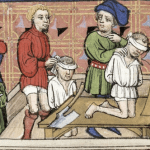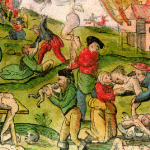 Animals
Animals  Animals
Animals  Weird Stuff
Weird Stuff 10 Weird Things People Used to Do at New Year’s
 Our World
Our World 10 Archaeological Discoveries of 2025 That Refined History
 Weird Stuff
Weird Stuff 10 Fascinating Facts You Might Not Know About Snow
 Miscellaneous
Miscellaneous Top 10 Things Crypto Was Supposed to Change & What Actually Did
 History
History 10 Huge Historical Events That Happened on Christmas Eve
 Music
Music 10 Surprising Origin Stories of Your Favorite Holiday Songs
 History
History 10 Less Than Jolly Events That Occurred on December 25
 Weird Stuff
Weird Stuff 10 Funny Ways That Researchers Overthink Christmas
 Politics
Politics 10 Political Scandals That Sent Crowds Into the Streets
 Animals
Animals 10 Species That Refused to Go Extinct
 Weird Stuff
Weird Stuff 10 Weird Things People Used to Do at New Year’s
 Our World
Our World 10 Archaeological Discoveries of 2025 That Refined History
Who's Behind Listverse?

Jamie Frater
Head Editor
Jamie founded Listverse due to an insatiable desire to share fascinating, obscure, and bizarre facts. He has been a guest speaker on numerous national radio and television stations and is a five time published author.
More About Us Weird Stuff
Weird Stuff 10 Fascinating Facts You Might Not Know About Snow
 Miscellaneous
Miscellaneous Top 10 Things Crypto Was Supposed to Change & What Actually Did
 History
History 10 Huge Historical Events That Happened on Christmas Eve
 Music
Music 10 Surprising Origin Stories of Your Favorite Holiday Songs
 History
History 10 Less Than Jolly Events That Occurred on December 25
 Weird Stuff
Weird Stuff 10 Funny Ways That Researchers Overthink Christmas
 Politics
Politics 10 Political Scandals That Sent Crowds Into the Streets
10 Middle-Earth Tales Worth Adapting
As good as The Lord of the Rings is, it’s far from the only story in Middle-earth. J.R.R. Tolkien crafted countless tales set in his fantasy realm. Not only do they give the world an immense sense of history, but they’re engaging narratives in their own right. Filmmakers should take notice.
Any of these stories would make for amazing adaptations in film, television, or video games. Aside from exciting you with dragons, demons, and other fantasy trappings, these tales craft harrowing journeys about unlikely heroes tackling impossible odds, all while conveying potent themes about greed, corruption, loyalty, and bravery.
Some of these stories are arguably more compelling than the mainline trilogy. That feat is a testament to Tolkien’s textual skills. All this praise is basically a plea to read the books, but watching these adventures onscreen is the next best thing.
Related: 10 Franchise Movies That Needed a Different Director
10 The Creation
To truly understand a story, you must sometimes go back to the beginning. Middle-earth starts in the black nothingness. The creator, Eru Ilúvatar, gives rise to the Valar. These beings function as gods controlling the land, sea, and air. They then join their master in song, their music forming the various landscapes of Arda and, by extension, Middle-earth. Along the way, Melkor (or Morgoth) tries weaving his own melody. He believes his plan is worthier than everyone else’s. That arrogance informs the rest of the world’s history.
This sequence is stunning. Songs are a prevalent part of Tolkien’s writing, so it’s beautifully fitting that music builds the world. In addition, the subject matter is downright biblical in nature, giving Middle-earth tremendous depth and shaking you to the core. That’s largely thanks to Tolkien’s poetic prose. These primordial pieces easily match the power of a religious epic.[1]
9 Fëanor’s Crusade
Morgoth later reaps revenge on the Valar. In the divine land of Valinor, Fëanor becomes famous among his fellow Elves for his craftsmanship. The Valar’s blessing enables him to create the Silmarils—jewels imbued with godly light. Sadly, Morgoth steals these treasures, murders Fëanor’s father, and drains the light from Valinor by poisoning the holy trees. The Elf then rallies his followers and pursues the dark god.
The Valar caution him against leaving the Undying Lands, but Fëanor goes to terrible lengths for his vengeance, even killing his kin to secure their boats. That drive ultimately proves his undoing as Morgoth outwits him and strands his fellow Elves in Middle-earth. The whole campaign is a tragic tale about arrogance corrupting purity.
Morgoth obviously demonstrates this corruption through his vandalism of Valinor, but Fëanor also falls victim to it. His natural gifts are initially a blessing, but the Elf becomes enamored with his own importance and uses his creations as a pretext for war, inadvertently destroying his people in the process. The downfall is sad enough on the page, but seeing such beauty marred onscreen would hit differently.[2]
8 Beren and Lúthien
These two comprise the most famous romance in Middle-earth. A life of hardship eventually brings a Man named Beren to an Elven kingdom, where he encounters the heavenly princess, Lúthien. They soon hit it off and wish to further their relationship. Unfortunately, Lúthien’s father refuses, joking that he’ll only relent if Beren brings him a Silmaril. The determined warrior sets off on that very mission, and his would-be lover secretly joins him. Through sheer will and guile, the pair overcomes impossible odds and even outfoxes Sauron and Morgoth. It’s no secret why this tale has endured.
Beren and Lúthien’s quest is one of the rare hopeful tales in the First Age. The characters’ devotion to each other is admirable, but their actions speak louder. Both of them put in a massive effort, using their unique skills to succeed. Each compensates for the other’s shortcomings. Not only does this buck the usual trend of medieval courtship, but it invests you in both heroes, rooting for them to live happily ever after. Star-crossed lovers make for easy drama, and this pair could give Romeo and Juliet a run for their money.[3]
7 The Fall of Gondolin
Gondolin is as impressive as it is elusive. Carved in immaculate stone, this kingdom serves as a sanctuary and a hub for eager craftsmen. The weapons, structures, and armor forged here earn widespread reverence for their beauty. Morgoth wants to blot out that beauty, but that’s nearly impossible due to the kingdom’s hidden location. Nevertheless, a Valar messenger warns of the villain’s imminent arrival, a warning which falls on deaf ears. The king’s covetous nephew opens the door to Morgoth’s forces, and the realm suffers a horrific massacre, leaving the few survivors as refugees.
As unfortunate as this outcome is, it offers a chance to flesh out the cultures and themes further. Elves don’t just work with trees; they’re capable of sturdy stone marvels rivaling the Dwarves. Proving this through Gondolin can vanquish any stereotypes about these effeminate people, forever altering audiences’ view of these immortal beings.
More importantly, the story reinforces the folly of faithless arrogance. The Elves ignore the Valar’s friendly warning, and their overconfidence brings further misery to Middle-earth. Even the most brilliant minds sometimes need help. That lesson can benefit everyone watching, making Gondolin a universal tale.[4]
6 The Children of Húrin
The war against Morgoth claimed countless lives. Among the most disheartening examples is Húrin. This champion of Men bravely holds off the enemy forces to allow his friends to escape. Morgoth then takes him captive, chains him atop a mountain peak, and gives him farseeing vision. The Dark Lord then wreaks untold suffering on Húrin’s people, and the hero must watch as his children come to ruin and death.
Upon finally being released, Hurin witnesses his wife die of old age and grief. This misfortune causes him to lead a band of outlaws—robbing and pillaging to survive. His desperate calls for aid also reveal the last free kingdoms to Morgoth’s forces. Seeing the damage he caused, the broken Húrin ends his own life.
Obviously, this tale isn’t exactly pleasant, but it does pack a punch. You can’t help but feel sorry for Húrin and his kin. As they try to make the best of a bad situation, their attempts only sink them further and increase their desperation. More than any other instance, this story illustrates Morgoth’s malevolent methodology. He doesn’t want to dominate; he seeks to corrupt. Your admiration for his sadistic ingenuity is matched only by your pity for his victims.[5]
5 Eärendil’s Plea
How funny that one of the Elves’ greatest heroes is a Man. Toward the end of the First Age, Morgoth has most of Middle-earth under his dominion. He’s crushed or corrupted most of his enemies, and the last holdouts are desperate for a solution. Eärendil, a Man descended from Gondolin, recognizes that things went wrong after the people shunned the Valar. Thus, he sails to Valinor to beg their forgiveness and seek their aid. The gods respond by routing Morgoth’s forces, imprisoning the villain for eternity, and granting divine honors to Eärendil and his family. In essence, he gains atonement for everyone’s sins, be they Elf, Man, or Dwarf.
That conclusion is comforting for people from all walks of life. On the surface, it brings the war with Morgoth to a satisfying end by snatching hope from hopelessness. On a deeper level, it affirms the healing power of faith and asserts that it’s never too late to seek forgiveness. The characters need that comfort after millennia of suffering. Such uplifting messages can get the audience through life’s trials as well.[6]
4 The Silmarillion
Here you have the Holy Bible of Middle-earth. The Silmarillion chronicles the vast history of Tolkien’s world, from his melodious beginning to The Lord of the Rings. As such, it includes many tales already outlined on this list. That fact might make it seem like a cop-out, but not quite.
You need only look at the big picture. As engrossing as these stories are on their own, they all add up to an overarching narrative. Many themes, characters, and plot threads carry over from one episode to the next. As a result, the elements have enhanced significance.
Nowhere is that more demonstrated than with the titular Silmarils. The desire for these jewels informs most of the pivotal battles and adventures, and their loss brings the story to a bitterly ironic end. Only by experiencing the longstanding conflict can you truly appreciate their corruptive power. By the same metric, you can only understand the magnitude of The Silmarillion by witnessing all its events.[7]
3 The Fall of Númenor
Amazon’s Rings of Power will eventually depict this disaster, but its roots stretch back long before this show. Númenor is an island kingdom granted to Men by the Valar. Unfortunately, the residents develop a desire, leading them to take up sailing. Although their expeditions to Middle-earth are initially peaceful, they soon begin asserting their dominance.
Sauron spots that weakness and stokes their resentment. He eventually manipulates them into invading the Undying Lands, where they can forcibly take the immortality enjoyed by the Elves. That act prompts Eru Ilúvatar to sink their island and its fleets. The only survivors are those who remain loyal to the Valar.
Númenor’s decline challenges you as a reader. Human beings naturally have ambition. It’s what inspires them to succeed in their pursuits. On that level, you can empathize with the islanders. However, there’s a fine line between ambition and selfishness, and it’s not always clear. Watching the Númenóreans cross that line is what gives the story such personal potency. Once again, Tolkien’s writing brilliantly prizes humility and faith over greed and hubris.[8]
2 The Fall of Arnor
Morgoth and Sauron aren’t the only devilish despots to make their mark. The Witch-king is just a tier lower. Not only does he lead the malevolent Ringwraiths, but he also commands his own kingdom of Angmar. In the Second Age, he wages war against Arnor, a northern kingdom of Númenórean survivors. The Witch-king razes this realm to the ground, leaving Gondor as the last major holdout for Men.
On top of presenting another engaging war, this conflict fills in some valuable gaps. Namely, it shows that the Witch-king is far from just another lackey. Conquering a rival kingdom displays maniacal ambition and strategic prowess comparable to Sauron himself. Likewise, destroying it shows the depths of his malicious capabilities. Fans see the aftermath in The Lord of the Rings with the Arnor ruin of Amon Sûl, so why not portray those prior events?[9]
1 The Battle of Green Fields
Hobbits generally avoid worldly affairs, but they can also become some of the greatest heroes. On top of those from the mainline tale, Middle-earth history recognizes Bandobras “Bullroarer” Took. He’s exceptionally tall for a Halfling, riding a horse instead of a pony. That size comes in handy when goblins invade his homeland of the Shire. Took charges their ranks head-on and swings his club straight at the goblin chief. The blow takes the villain’s head off and sends it down a rabbit hole, winning the battle and inspiring golfers for years to come.
You might notice that this tale isn’t as heavy as other entries, but that’s no bad thing. Hobbits are inherently more innocent than other races, thanks to their humble lifestyles. A tale about these little folks could make a refreshing change of pace. Plus, it could strengthen their underdog appeal.
These guys are the unlikeliest heroes in Middle-earth, yet one of their own leads the charge against an overwhelming foe and emerges victorious. That brave act exhibits courage well beyond their meager size, making you admire these Halflings even more. People love watching David triumph over Goliath, and Hobbits perfectly embody that scenario. Why not get to know one more? [10]








